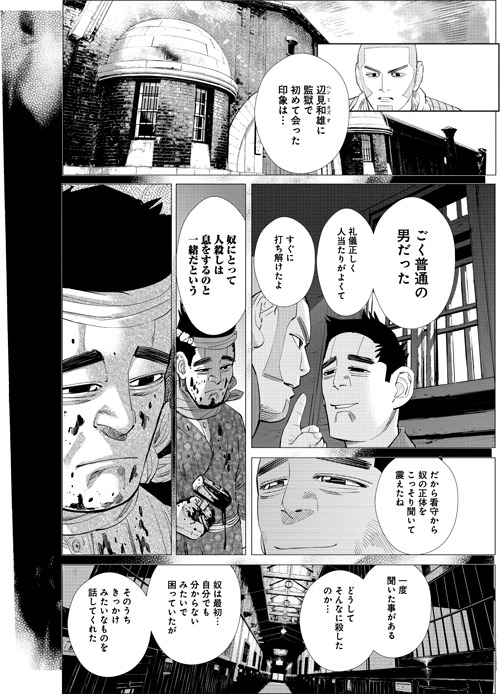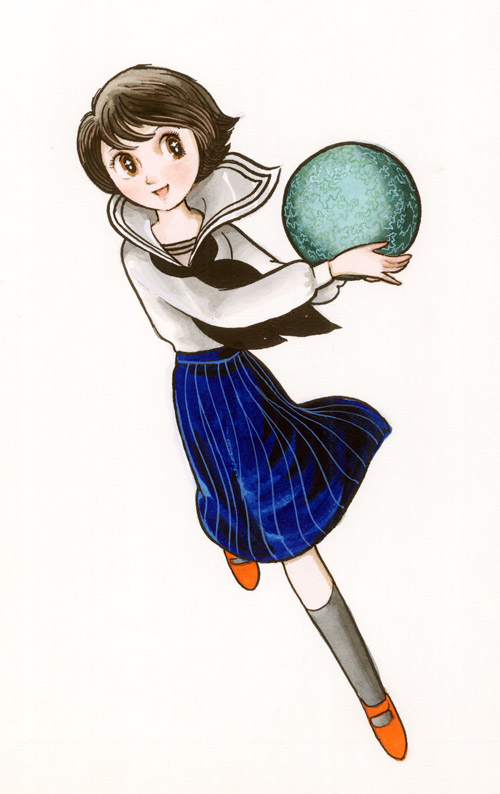Noda Satoru was interviewed for Tezuka Osamu’s official website after he won the Grand Prize in 22nd Tezuka Osamu Cultural Prize.

On writing about the Ainu
Congratulations on the award.
The story of Golden Kamuy starts with the meeting between the Ainu girl Asirpa and Sugimoto Saichi, a tondenhei who has just returned from the Russo-Japanese war.
I think the very attractive depiction of Asirpa and the life in her kotan is one of the great characteristics of this work, but on the other hand for a long time writing about Ainu culture has been thought to be difficult.
During the process of conceiving Golden Kamuy, was there any trouble or concern about writing about the Ainu?
I was prepared of the possibility that this work might get axed any time.
Humbly, without pretending to be in the know, I frequently consult the experts about Ainu culture as much as possible, but if I make any mistake, I should with all my might apologise and make corrections for the tankoubon (comic book). That was the major principle.
At Shueisha I studied examples of depiction of the Ainu that was a major problem in mass media, but there was only obvious prejudice and malice. However, whatever other people say, I want to treat the Ainu and the Wajins equally. There are good people, there are bad people. I don’t think we can say that there is an ethnic group without any bad guy among humans.

Your debut work was Kyouko toiu kyou no kyou which won an award from another publication, but now you’re Weekly Young Jump’s star author.
Long story short, I brought the idea about an ice hockey manga to Young Jump, and by chance the one who took a look at it was my managing editor now, Ookuma Hakkou. If I think about it now, that time I really got lucky. Ookuma was also the one who brought me the novel about hunting that inspired Golden Kamuy. When I read the novel, probably my glasses gleamed.
I heard that you got inspiration from a work by Kumagai Tatsuya, but did you also read other books?
Ginrouou was the only book by Kumagai Tatsuya that I read. I haven’t read the others. Previously, I heard from those in-the-know about the Ainu that works of literature that feature the Ainu too contain mistakes, so I avoided works of literature as much as possible; and I’d already got too many monographs about the Ainu that I had to read, so I had no spare time to read works of literature. I decided that since the works of literature don’t contain too much information, reading them would be pointless. It’s like flipping through Shiraishi’s jail-breaking past story.

How the ‘Japanese yaminabe Western’ was created
I think the stories you write increasingly progress towards the direction unexpected by the readers. How did you come up with the idea?
I think things that occur to us suddenly can also be easily expected by readers, so I drive myself to a corner, and before I’m cornered, I find an escape route that is unexpected. Contrary to expectations, what’s needed is the boldness to create shit, not to create the highest-grade curry prepared from various high-class ingredients.

The work deals with serious themes, but plenty of gags are also included.
Since I first debuted with a gag manga, I enjoy drawing gag scenes. In meetings with my editor Ookuma-san, he would say things like “Since it’s been too serious, next let’s have them enjoy eating something in a heartwarming way” or “Too many jokes lately, why don’t we return to focus on the main storyline?”
I also think that the fascinating characters make the work even more fascinating. Both the convicts who hold the key to the secret code and the ones who are after them are a bit wrong in the head, we can’t call them ‘model citizens’. Perhaps we should call them outlaws, yet sensible?
It’s because multifaceted characters would definitely create a pre-established harmony. A clearly evil person would make readers think that they want them dead, leading the main character to punish them.
That development is ordinary and boring.
Even though those characters are villains, if readers don’t want them to die because they have some attractive quality that commands respect, I’ll take it as a success.
By the way, I don’t have any bit of an outlaw in me; I think I’m more of an antisocial person who doesn’t clean up the poo when taking his dog out for a walk.

I also pay attention to the outfits of the characters, from the blend of Japanese and Western styles worn by Sugimoto and Shiraishi, to the Ainu clothes worn by Kiroranke and Asirpa; to me they are drawn with painstaking details. I think to portray various specific characters, you would need various bits of information. Actually, is there any part that you think difficult?
Rules of military uniforms are incredibly difficult. There are many various differences such as the position of the braiding, the length of the coat, the epaulettes, the shapes of the sword tassels, uniforms for summer and for winter; moreover, after the Russo-Japanese war the designs were changing, so it is really difficult, and there are various instances where I get it wrong which I regret to no end. Military uniforms are even more difficult than the detailed Ainu clothes.

In Young Jump magazine where Golden Kamuy is serialised, Tanigaki appeared on the gravure page, and it became much-talked. If you could choose one person to make a fake photobook of, wouldn’t that person be Tanigaki?
I still want to draw more of Tanigaki gravure pictures. More so that I can fill the first and the last pages of the magazine with them. I also really think it would be great to have Tanigaki gravure picture on the cover. It was rejected. I am still not giving up.
(Young Jump is known for having gravure pictures of young ladies on the cover. – Translator)

By the way, which character is popular among fans? Also, do you echo the sentiment? Or were you quite surprised about their choice?
I regularly accept questions from readers on Twitter, and what I understand is that lately there are so many questions about Sergeant Tsukishima. I too draw him thinking “A man like this is cool.” I’m glad that women too seem to approve this.
Ogata too is popular among women. That I just don’t really understand.
Since I just draw him without thinking too deeply, I wonder if this is a good thing?

Have you read Tezuka Osamu?
Since this is Tezuka Osamu’s official website, there is something we’d like to ask you. Tezuka Osamu too once wrote Ainu-themed works, Shumari and Yuusha-dan, and in the postscript he wrote “Since I am a naichijin (an old word for Wajin – translator), a conqueror, there is no way for me to understand the feelings of the Ainu that have been victimized.”
Have you read them?
I have never read Shumari. There are some points of similarities that I learned later, but I just think that if we collect interesting materials about Hokkaido, there’s bound to be some overlapping in ideas.
It’s awesome that Tezuka-sensei was the first to recognise what’s interesting about Hokkaido.
Could you tell us what your favourite work by Tezuka, or his work that left an impression on you, if any? When did you pick it up, and why?
I’ve read Black Jack and Mitsume ga tooru (The Three-Eyed One) because we had them at home when I was very young. I remember thinking how sensual and extraordinarily fine Wato-san was. (Wato is a character in The Three-Eyed One – translator.) Although if I read it now, she doesn’t seem to be that full-figured anymore.

Forget everything behind the scenes
Please give a message to the readers.
Actually, I have no intention to talk too much about inside stories. Please forget all these behind-the-scenes and immerse yourself in the work. Don’t give a damn about the author. You don’t have to find out about him. You would feel the characters more if you enter the work deeply until you believe that the world it depicts might really exist.
I will be glad if that happens.
Thank you for giving us your time although you’re busy!
Original interview here. Corrections, suggestions welcome.

ahaha, thanks for the translation this blogs great. 😀 ❤
LikeLike
Pingback: Golden Kamuy Season 3 release date: OVA 2 episode confirmed for 2019 - Golden Kamuy manga compared to the anime and Satoru Noda interview [Spoilers for Sugimoto, Asirpa, Nopperabou]
Pingback: Golden Kamuy Season 3 release date: OVA 3 and OVA 2 episodes confirmed for 2019 - Golden Kamuy manga compared to the anime and Satoru Noda interview [Spoilers for Sugimoto, Asirpa, Nopperabou]